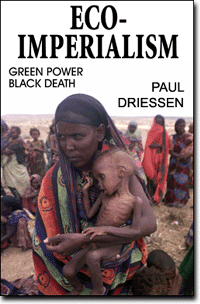It’s time to remove life-threatening chemical phobias from laws and public policies
by Paul K. Driessen
November 2004
Millions of people may have gotten an eleventh-hour death-row reprieve when President Bush won re-election. His commitment to ending killer diseases in developing countries is rock solid – whereas his opponent’s environmental views often obstruct progress.
Senator and Mrs. John Kerry are big fans of Rachel Carson, whose disingenuous book Silent Spring launched the radical anti-pesticide movement that Teresa Heinz Kerry still bankrolls through her family philanthropies. Had they taken the White House public policy reins, pesticides would have virtually disappeared as a vital method for controlling deadly insect-borne diseases.
THK applauds the “banning of DDT and other harmful pesticides” as vital to ending the “devastating triple whammy” that women get from “the chemical soup” of birth control pills, makeup and sunblock, and “daily games of golf” on courses that are “perfectly manicured, thanks to estrogenic pesticides.”
“Drift is something we cannot afford when it comes to human rights,” she insists. But her notion of human rights neglects the most basic one: life itself. Her concern about speculative harm from chemicals drifts into misplaced opposition to substances vital to preserving life in her native Africa.
Every year, up to 300 million Africans get malaria; up to 2 million die. Millions more perish from typhus, tuberculosis, dysentery, malnutrition, AIDS and other serial killers they would likely survive if they didn’t also have malaria. Other countries – like India, Bangladesh, Sri Lanka, Vietnam, Brazil, Surinam and Peru – also have serious, worsening malaria problems.
Kenya lost 34,000 children in 2002 from malaria, and 170 million working days: people who couldn’t work or stayed home to care for sick family members. Malaria drives Africa’s gross domestic product $12 billion a year below what it would be were the disease not endemic, and drains $730 million a year from India’s economy.
Were the United States hammered by malaria to the degree sub-Saharan Africa is, over 100,000,000 Americans would be infected every year and 500,000 would die – half of them children. Agonizing cycles of 104-degree fevers, body-shaking chills, convulsions, diarrhea and vomiting would leave many unable to work, for weeks or months on end, others with permanent brain damage.
Families would be torn apart, our healthcare system overwhelmed, our economy devastated. We would demand immediate action to end the epidemic – including widespread pesticide spraying – and wouldn’t tolerate objections from “the international community.”
But we no longer have malaria – thanks largely to pesticides. As a result, though, many Americans now have country-club anxieties about chemicals and feel smug about exporting their newfound environmental idealism. They’re not alone.
Through laws, treaties, trade sanctions and aid programs, the U.S. Agency for International Development, World Health Organization, UNICEF, EU, wealthy donors like THK and the environmental activists she supports demand that poor countries never use pesticides – especially DDT. Instead, their citizens’ must entrust their lives to politically correct strategies like insecticide-treated bed nets, which may reduce malaria by 40 percent. Worse, until mid-2004, the WHO, UNICEF and USAID provided anti-malarial drugs that they knew for years fail as much as 80% of the time.
Rural areas in these countries don’t have clinics with electricity and clean water, or even decent roads. They can’t possibly provide nets, drugs, care or vaccines that still don’t exist to hundreds of millions of at-risk people. Without pesticides, millions more will die.
Sprayed on walls and eaves of mud-and-thatch homes, DDT keeps 90% of the mosquitoes out for six months or more, kills any that land on walls, and irritates the rest, so they don’t bite. Its alleged toxicity to wildlife was due to faulty, even fraudulentlab studies, its being mixed with petroleum distillates, and discharges of lead, mercury and other chemicals into waterways. Numerous studies showed it is not harmful or carcinogenic to humans.
South Africa and other countries have proven that DDT, nets and modern drugs together slash malaria disease and death rates by 90% or more. To say any country should be content with 40% reductions is an intolerable human rights violation.
But activists bullied dozens of poor countries into signing the Stockholm Treaty, committing them to phasing out pesticides. They’ve now eviscerated the exemption for pesticides to control disease, by warning of aid cuts and bans on agricultural produce bearing traces of DDT, and emphasizing rich-country concerns about early lactation, aesthetics (DDT leaves a white residue on walls), and “detectable” DDT in breast milk.
“I lost my son, two sisters and two nephews to malaria,” says Uganda’s Fiona Kobusingye. “Don’t tell me a little DDT in our bodies is worse than losing more children to this disease. African mothers would be overjoyed if that were their biggest worry.
Novelist, film producer and PhD molecular biologist Michael Crichton said “banning DDT is one of the most disgraceful episodes in the twentieth century history of America.” Until an alternative is found, said the New York Times, “wealthy nations should be helping poor countries with all available means – including DDT.” Clergy, doctors, civil rights leaders, other newspapers and even Ralph Nader agree.
And still the wealthy doyenne who sought to be the next First Lady and Presidential-Adviser-in-Chief frets about distant, hypothetical risks. It’s time for President Bush and the new Congress to do whatever is necessary to end the real, immediate, life-threatening dangers the world’s poor face every day.
